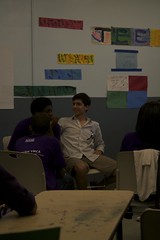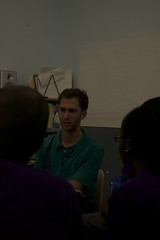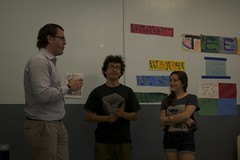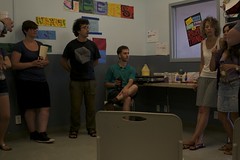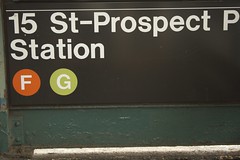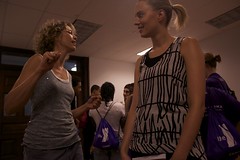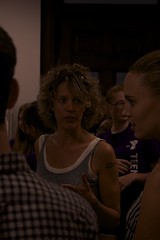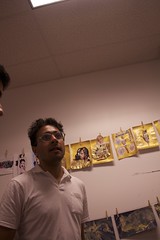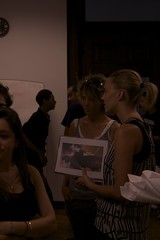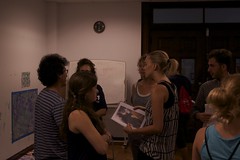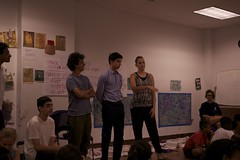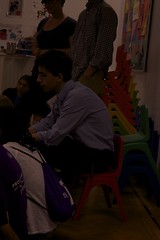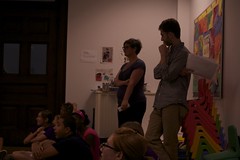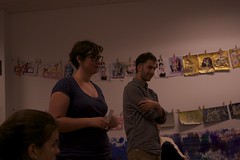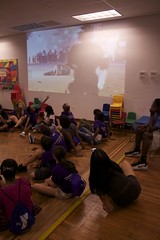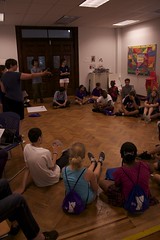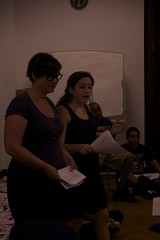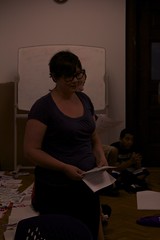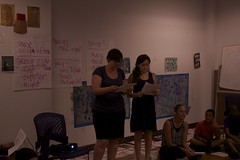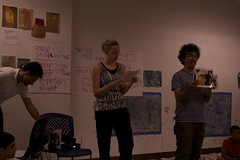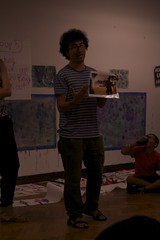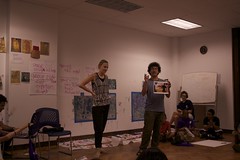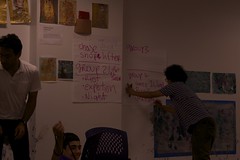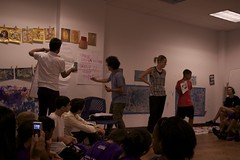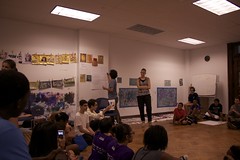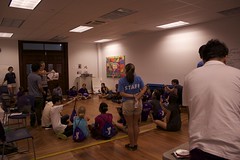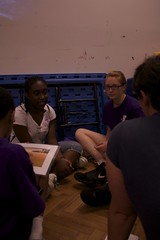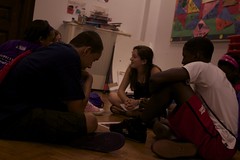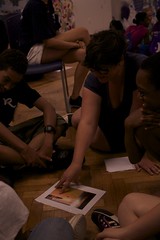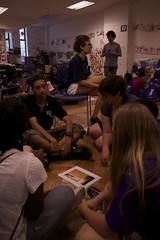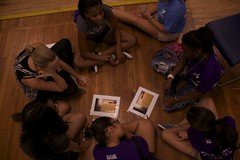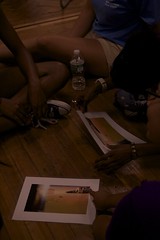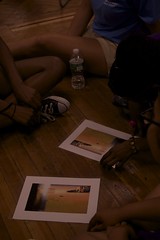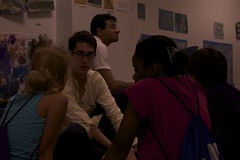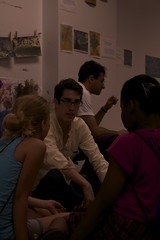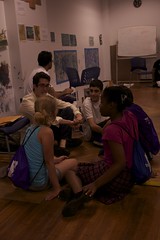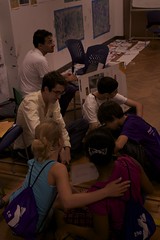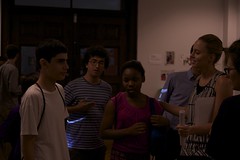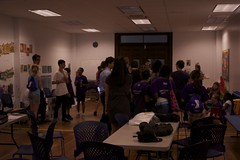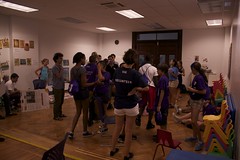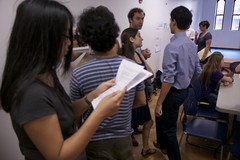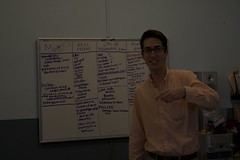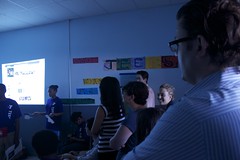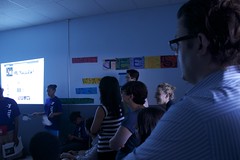Workshop with LAMPcamp, July, 2011, New York City, NY:
The Youth and Media team spent July 25 and 26 2011 in New York, visiting the LAMPcamp. The LAMP – the Learning About Multimedia Project – is a non-profit organization that works to reform and improve media and media literacy. The Lamp periodically holds free workshops for youth, parents, and educators, each focusing on issues intimately related to this goal. To this end, the LAMP partners with the YMCA for several weeks during the summer, working with a select group of students on advertising, documentary production, and news issues. We spent the first day in Park Slope and the second in Flatbush – both in Brooklyn – teaching a group of students – diverse in both age and background – about information quality and related concepts.
Day 1
Workshop at LAMPcamp – Same image, different story
The Youth and Media team spent July 25 and 26 2011 in New York, visiting the LAMPcamp. The LAMP – the Learning About Multimedia Project – is a non-profit organization that works to reform and improve media and media literacy. The Lamp periodically holds free workshops for youth, parents, and educators, each focusing on issues intimately related to this goal. To this end, the LAMP partners with the YMCA for several weeks during the summer, working with a select group of students on advertising, documentary production, and news issues. We spent the first day in Park Slope and the second in Flatbush – both in Brooklyn – teaching a group of students – diverse in both age and background – about information quality and related concepts.
On our first day at LAMPcamp, we met with a group of students (between 12 and 14 years old) in their second week of camp. They had spent the first week learning about advertisement and were beginning their journey into the realm of news and news reporting.
Our workshop, therefore, focused on news stories and different points of view. We aimed to familiarize the students with the numerous perspectives from where any given situation could be understood. To do this, we focused on a particular story – the Vancouver Riot Kiss – and explored its’ presentation through various forms of media. We began by splitting the students into small groups, and gave each a cut-up of the Vancouver Riot Kissing Couple photograph (Photograph by Rich Lam/Getty Images). One group, for example, had a cut-up of the policeman at the foreground of the photograph; another group had a cut-up of the background riots; another one a cut-up of the couple in the middle-ground. We gave the students several minutes to come up with the story behind the image – to figure out who the protagonist is and where and what he was doing. After developing these stories, students presented them to the entire class.
The breadth of the stories was immediately evident; each group told a story entirely different from the others. For example, one group told a story about “James” and “Samantha,” a couple spending the afternoon at the beach. Another group focused on the FBI and a robbery, telling a story replete with drama and crime. After sharing all their stories, we showed the students the original image, revealing to them that they had each only a piece of the original photograph.
Furthermore, we contextualized the story of the Vancouver Riot Kiss to the students telling them that it happened after the final game of the Hockey Stanley Cup in Vancouver between the Canucks and the Bruins. They were intrigued by the story and described the image as romantic and weird; they didn’t understand why a couple would be kissing in such a public space. Then, we introduced the second part of the learning activity by drawing on the student’s comments, mentioning that different media covered the story, intrigued by this kissing couple.
First, we showed them a video from the Young Turks Network. The reporters in this video spent little time discussing the riot itself, instead focusing primarily on the romance of the kiss. This narrative was much in line with the narrative the kids came up with after seeing the entire photograph and many students were interested in knowing what had happened. Some were even wondering if this “kissing couple” were rioters as well. We then showed them an amateur video taken by a Canadian bystander, a man who stood on the roof of a building overlooking the riot. This video focused almost exclusively on the violence of the riot, showing fans running through the streets much to the chagrin of the tear-gassing police. In a small part of the video “the kissing couple” can be seen pushed to the ground by the police, noticeably upset by this violence. The story told in this video – though based on the same event and same characters as the previous one – is far from romantic, reflecting the point of view of the witnessing bystander. The kids realized that the story they had been told earlier had not been complete, and they came to the conclusion that there was no romance to be found after all. A debate started on whether or not “the kissing couple” were rioters or innocent bystanders.
Then we gave each group two printed articles that told the story of the kissing couple (“Vancouver kiss couple ‘were knocked down by riot police.’” from the Guardian; and “Overlooked Vancouver Video Shows ‘Kissing Couple’Was Knocked Down by Riot Police” from the New York Times). We asked the students to describe the differences between the two, and to consider what additional stories might not have been told. In this latter discussion, a student mentioned that the point of view of the kissing couple was missing; they were intrigued by this story and wanted to know what had “really” happened according to them.
We then showed them a portion of an interview given by the kissing couple several days after the event. The kids talked with us about the importance of perspective, reinforcing the argument that different stories can be told about the same event, each story a reflection of the teller’s point of view. They were interested to hear the police officers account of the story and disappointed that, besides a few sentences in the newspaper article, there was no additional material to tell that story. All in all, it was a very engaging and inspiring day!
Day 2
LAMPcamp – Perspectives on Information: Digital Breadcrumbs
On our second day in New York, we visited the LAMPcamp at the Flatbush YMCA. The group of students we met had spent the first week of the camp learning about news and were beginning to do projects on advertisement. We spent the first hour discussing with the students a wide array of topics such as their Facebook use, their search techniques, and their engagement in content creation, among others.
After that, we run a workshop about how people interpret the same information differently. Our warm-up activity centered on defining perspective. We first showed them an optical illusion and asked them what they saw. We emphasized that their differing interpretations depended on perspective. We gave another example of Billy, a student who makes the baseball team; different people in Billy’s life react to the same event differently depending on their relationship to him. The students then gave their definitions of perspective.
Our second activity centered around Facebook. After splitting the students into small groups, we asked each to put on a “thinking cap” and play different roles as they evaluated a Facebook profile of one of the YaM team members. One group was asked to be a mother, one a teacher, one a friend, one a girl at school, and one a potential future boss. We told the groups to analyze the profile from the perspective of their given character, providing a list of assumptions, “likes,” “dislikes,” and comments. We also asked students to consider how their findings might affect their future relationship with the person whose page they had viewed. To facilitate the role playing we handed out props for each team to wear and embody the different personas.
After considering this question in their groups, the students presented their analyses, mentioning to the class what they had “liked” and “disliked,” and why. We also discussed implications for future relationships. The groups responded differently to the profile, “liking” and “disliking” entirely different aspects. They immersed themselves in the roles taking on various tones and mannerisms. The message was clear: perspective matters greatly in determining interpretation of the same information.
The third activity focused on how different perspectives can arise from different sets of information. We split the students up into two groups and gave them each a set of clippings from social network websites that reflected a fictional character, Sarah Donnum. Two-thirds of the information was the same, but one-third differed to paint Sarah in either a positive or negative light. We asked each group to figure out who this character was and what she had done.
Each group then presented their analyses. One group spun a story about how Sarah strives to get good grades so she can get into a good college. Another group told an entirely different tale about how she turns to a life of crime after her father dies.
Finally, we led a closing discussion to tie the activity into the central theme of perspective. We emphasized how one piece of information can skew perspective on another piece. We also introduced the concept of digital breadcrumbs: the idea that you leave behind information through a online presence that others can then use to judge you. This idea resonated with students, all of whom cared about what information was linked to their names online. The class concluded that people can judge information differently based on different perspectives and access.



